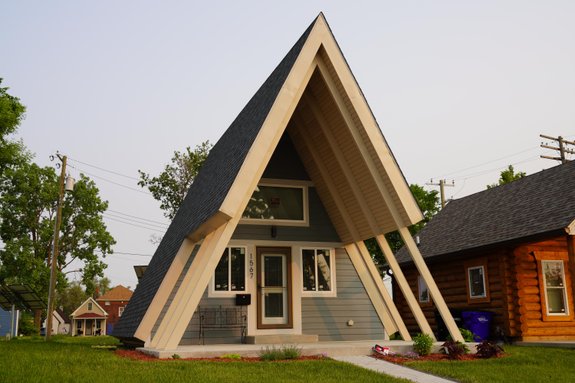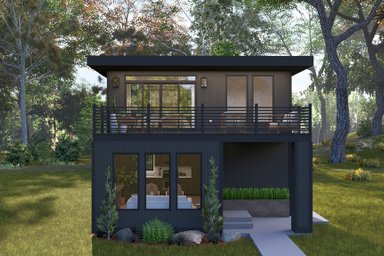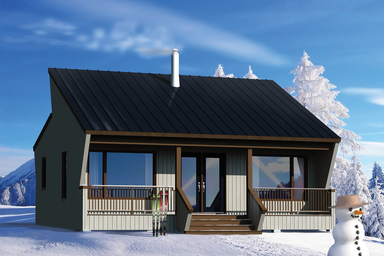By Aurora Zeledon
Years ago, we wrote about a remarkable program that was building tiny homes for those in need, with a clear path to homeownership for participants after seven years.
Recently, the first two participants achieved that goal and were handed the deeds to their own homes.
The nonprofit is called Cass Community Social Services and operates in Detroit. In their own words, they provide "basic needs, including affordable housing, promoting self-reliance and encouraging community involvement and community improvement."
Learn More About Cass Community and the Tiny Homes Project
 Image courtesy of Rev. Fowler. Get a similar look with tiny house plan 57-501.
Image courtesy of Rev. Fowler. Get a similar look with tiny house plan 57-501.
The Reverend Faith Fowler, executive director of Cass Community Social Services, recently talked with us on the phone. The following interview has been edited and condensed for clarity.
Would you tell us more about Cass and this project?
Sure. Well, Cass Community Social Services grew out of Cass Community United Methodist Church. The church started programs with people in need during the Great Depression.
So began a soup kitchen that really expanded and developed into the social services we know today. It was founded as a separate nonprofit in 2002 and we do food, housing, health care, and jobs.
This particular program grew out of our work with unhoused men, women and children. We deal with a couple hundred every night, three or four hundred every night, and the staff does a good job at helping people move out, move up after helping them get their lives together a little bit, maybe a job, maybe a car, maybe entitlements, reuniting with family. That sort of thing.
But they would come back because life happened to them, not cause they necessarily did anything wrong. But maybe their car broke down and they didn't have money to fix it and now they've lost a job. Or they got sick and they didn't have health insurance, and now they've lost a job. And whatever it is, they come back more deflated. And you think to yourself, well, how horrible. They did everything right. And they lost out anyway.
So the long and the short of it is began looking for a way for people to have a safety net. And then my mom died and left me, among other things, a house. And I thought, bingo, that's how the middle class does it. That's how we pass on wealth and stability is generationally, maybe you don't get a house, maybe you get a car. Maybe you get money or whatever it is you get if you're middle class, you get something usually. And then I began looking for a way to do that with people who didn't come from middle class families, who came from poor families.
And I was reading about people who were using tiny homes in the village style, which is really usually a tiny bedroom. It may or may not have electricity. It may or may not have plumbing, but it was meant as an alternative to shelter. Especially for people who were living in encampments and relish the fact of having a door and privacy and a bit more stability than you would being sort of mopped up by the police every couple weeks.
But it doesn't really solve the problem and we do shelters and I know shelters aren't the answer, but I'm not interested in doing any more shelters, and so then we toyed with the idea of creating a homeownership program using tiny houses.

And that's what we ended up with. A seven-year program for folks who have an income. In other words, we're not picking people up off the street saying here, here have a house cause you'd never be able to stay there, right? But people who have been homeless, people have been incarcerated, people have been through foster care, or senior citizens, all of whom are low income, have an income, not no income. A couple of people don't fit any of those categories, but they get extra points if they do in the scoring system. And they have to agree to be in the program, which means living in the house. We learned that one a very hard way. Unfortunately, somebody thought they could live somewhere else and still get the house. But we've always had a waiting list of folks to get in.
We built 25 over the first seven years. They're all occupied. And the first two residents just got their homes in September. And by that they got the deed. There was no mortgage. There was no land trust. It's theirs. They can use it for collateral. They can sell it if they want. They can leave it in their will.
So of the first two, one was a senior and one was someone who came out of foster care. The young man who came out of foster care moved in with us. He was making $480 a month. Now you know, not even Habitat would be able to accommodate him because they have a mortgage. Good program, great program, but they have a mortgage and they wouldn't have considered somebody at that low level.
When he got his deed on the 30th of September, Zillow says his house is worth $90,000.
Wow.
So that's the kind of change we were looking to enable. The woman who was a senior, Zillow said her house is worth $70,000. She's never owned a home in her whole life, so it changes everything. Not only do they have a place they love, and it is beautiful, right? It just changes everything.
And we live in Detroit, where redlining was horrible. I mean, people in the African American community, even if they had the money, couldn't have bought a house back in the day. So lots of things are solved. Not for everybody. Not everybody wants to live in a tiny house or can live in a tiny house, but it's really economic mobility in a way I couldn't think of to offer it, I couldn't think of a better way to do it.
So what do people have to do to qualify for it?
So to qualify, they simply have to be low income. To participate in it, they have to live in the house as their primary residence. Beyond that, every other month they come to a monthly meeting with all the other residents. So they get to know each other and so they get to ask questions about their homes. If you'd never owned a home before, you don't know when to clean the gutters, when to change the filters, when to shut off the outside spigot. All those things that we learned from our parents, right? They didn't. So they do that once a month. They get some financial literacy classes. Some need them, some don't, by the way. But do you have a budget? Do you have a bank account? Do you know your credit score? Have you ever invested any money? Let's show you some ways you could do that so that you have some reserves when you own the house and the hot water tank goes out.
And the last thing is they have to volunteer four hours a month, every month, for all seven years. They pay a dollar a square foot. So they're paying roughly half to one-third of what they'd pay anywhere else here in Detroit. And the other thing they pay is their electric bill cause we wanted them to have a sense of you control what your bill's going to be by how much you use, right? We also put in solar arrays to basically eliminate their bill in the summers, to reduce it drastically in the spring and fall, and then to make a dent in it in the winter. That's it.

So the dollar per square foot, does that go to Cass communities to offset the cost of the house?
So we raised the money to build the houses privately. Individuals, corporations, foundations, no government money. So the money's all raised to build the house before a shovel goes in the ground.
What we use the [dollar per square foot] for is to cut the grass, to shovel the snow, to pay for the taxes, or the garbage collection. Their security system, their ADT protection program for their appliances. So we use it to pay their bills. At the end of seven years, we know they can live on their amount of money because we've been paying their bills the whole time. We just stopped taking their rent and they pay their own bills.
What about property tax afterwards?
It's all on them. We had a discussion with the county treasurer; it should be less than $1,000 a year. We tried to figure everything in, obviously a few things we learned along the way, but we did put a couple deed restrictions in. We said that you could do an addition to the house up to 750 square feet, meaning total not the addition, if they wanted to add, they wanted to extend. We still wanted them to be tiny homes, but we wanted to give them permission, if you will, to add on if they wanted to add an extra room, right. So that was one thing. Another thing is they can rent it out as a landlord, but they cannot turn it into an Airbnb. We didn't want 25 houses next to each other with different people every single night. That would be a nightmare.
So what happens if they lose their income during that seven-year period?
We've helped them. Obviously we did this during COVID, so if somebody lost a job, we're able to give them a job here at Cass. We didn't have to do it many times. Actually, we had a couple people lose jobs and then ended up with jobs that paid more money.
Oh, that's good. Wow. So have you had to kick anyone out of the program entirely?
Well, the one woman who didn't live in the house, she actually forced us to evict her. And it was ugly. But we're building these houses for low income folks and to have a house sit there empty for three years was making us nuts. It was not fair. Other than that, we haven't kicked anybody out. We've had a couple people die, but folks are are happy in the houses, quite frankly.
And do they own the land that the house is on, too?
Yep, at the seven-year mark. They own the land. They own the house. They own the solar array.
Can you tell me a little bit more about choosing the designs for the house?
So my mom always said if we were driving through a neighborhood, I can tell you where the sofa is on that wall, meaning all the houses are the same, there's nothing creative or fun about it, and I've always kept that in the back of my mind that if you're poor, you tend to live in, you know, identical and ugly housing that everybody can tell you what it's like inside. And so I wanted to create housing that was unique and very attractive. And so we began just looking on the internet and found Houseplans.com and bought from them the very first house [plan], the Tudor house that became the cover for the book and is associated with the program. And then after that we bought many. I don't know, ten or twelve more of them, I'd say.
[Editor's note: some of the plans used for the Cass Community tiny home program were purchased form Houseplans, while others came from different sources.]






